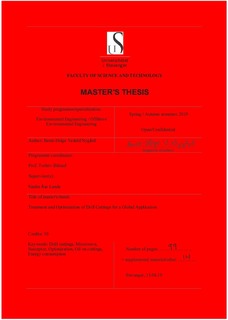| dc.contributor.advisor | Bilstad, Torleiv | |
| dc.contributor.author | Nygård, Bernt-Helge Vedeld | |
| dc.date.accessioned | 2019-10-22T10:27:33Z | |
| dc.date.available | 2019-10-22T10:27:33Z | |
| dc.date.issued | 2019-06-15 | |
| dc.identifier.uri | http://hdl.handle.net/11250/2623675 | |
| dc.description | Master's thesis in Environmental engineering | nb_NO |
| dc.description.abstract | Oil contaminated drill cuttings is considered as a significant waste stream in the oil and gas industry. Drill cuttings contain drilling fluids that interfere and destroy the life basis for animals in the sea. Various discharge limits for oil on cuttings is applied at different locations worldwide.
OSPAR have determined the discharge limit for its members to not exceed 1% OOC. The NCS is member of OSPAR but must also follow local regulations. The Norwegian Environment Agency (NEA) tend to practice stricter regulations as they follow BAT. Projects initiated by NEA have granted specific discharge limits at specific oil fields based on BAT.
The goal of the research carried out is to optimize a new treatment technology developed by Norwegian Technology AS. The optimization carried out was on basis of energy consumption and oil separation. The technology was also evaluated for various types of drill cuttings, from Canada and the NCS with the objective to investigate technology robustness. In addition to optimization of oil separation, energy consumption and technology robustness, a part of the process (condenser) was further investigated to determine its performance.
Three different drill cuttings were received from Conoco Phillips and Husky Energy and treated with the technology from Norwegian Technology AS. Testing of Conoco Phillips 17-inch section was performed in collaboration with a fellow student, Edward Reilly. The drill cuttings from Conoco Phillips 17-inch section was named CP17 and achieved an oil separation of 99.9% using 247 kWh/ton. Two different types were received from Husky Energy, which was named HE1 and HE2 achieved and oil separation of 81.7% and 96.3%, respectively. HE1 was centrifuged before treatment due to troublesome distribution of the drill cuttings in the sample holder during microwave treatment. The new treatment technology proved to increase oil separation and decrease energy consumption compared to microwave technology.
The robustness was also tested as the characteristics of the DC were variating. Treatment of CP17 and HE2 achieved OOC below 0.5%, while HE1 did not achieve OOC below 1%. However, results indicated that further optimization on HE1 could reach oil separation below OSPAR regulations.
Condensate from treatment was examined for product recovery. Oil in water was analyzed to be 0.55 mg/L, which is within OSPAR’s regulations for discharge of dispersed oil in water of 30 mg/L. Separated oil can be reused as it did not show signs of cracking. | nb_NO |
| dc.language.iso | eng | nb_NO |
| dc.publisher | University of Stavanger, Norway | nb_NO |
| dc.relation.ispartofseries | Masteroppgave/UIS-TN-IKBM/2019; | |
| dc.rights | Navngivelse 4.0 Internasjonal | * |
| dc.rights.uri | http://creativecommons.org/licenses/by/4.0/deed.no | * |
| dc.subject | teknisk miljøvern | nb_NO |
| dc.subject | offshore teknologi | nb_NO |
| dc.title | Treatment and Optimization of Drill Cuttings for a Global Application | nb_NO |
| dc.type | Master thesis | nb_NO |
| dc.subject.nsi | VDP::Technology: 500::Environmental engineering: 610 | nb_NO |

